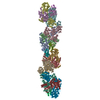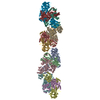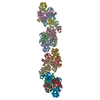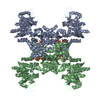+ Open data
Open data
- Basic information
Basic information
| Entry | Database: EMDB / ID: EMD-2700 | |||||||||
|---|---|---|---|---|---|---|---|---|---|---|
| Title | Cryo-EM structure of the CTP synthetase filament | |||||||||
 Map data Map data | reconstruction of CTP synthetase filament | |||||||||
 Sample Sample |
| |||||||||
 Keywords Keywords | nucleotide biosynthesis / enzyme polymerization / enzyme regulation / CTP / UTP / ATP | |||||||||
| Biological species |  | |||||||||
| Method | helical reconstruction / cryo EM / Resolution: 8.4 Å | |||||||||
 Authors Authors | Kollman JM / Charles EJ / Hansen JM | |||||||||
 Citation Citation |  Journal: Elife / Year: 2014 Journal: Elife / Year: 2014Title: Large-scale filament formation inhibits the activity of CTP synthetase. Authors: Rachael M Barry / Anne-Florence Bitbol / Alexander Lorestani / Emeric J Charles / Chris H Habrian / Jesse M Hansen / Hsin-Jung Li / Enoch P Baldwin / Ned S Wingreen / Justin M Kollman / Zemer Gitai /   Abstract: CTP Synthetase (CtpS) is a universally conserved and essential metabolic enzyme. While many enzymes form small oligomers, CtpS forms large-scale filamentous structures of unknown function in ...CTP Synthetase (CtpS) is a universally conserved and essential metabolic enzyme. While many enzymes form small oligomers, CtpS forms large-scale filamentous structures of unknown function in prokaryotes and eukaryotes. By simultaneously monitoring CtpS polymerization and enzymatic activity, we show that polymerization inhibits activity, and CtpS's product, CTP, induces assembly. To understand how assembly inhibits activity, we used electron microscopy to define the structure of CtpS polymers. This structure suggests that polymerization sterically hinders a conformational change necessary for CtpS activity. Structure-guided mutagenesis and mathematical modeling further indicate that coupling activity to polymerization promotes cooperative catalytic regulation. This previously uncharacterized regulatory mechanism is important for cellular function since a mutant that disrupts CtpS polymerization disrupts E. coli growth and metabolic regulation without reducing CTP levels. We propose that regulation by large-scale polymerization enables ultrasensitive control of enzymatic activity while storing an enzyme subpopulation in a conformationally restricted form that is readily activatable. | |||||||||
| History |
|
- Structure visualization
Structure visualization
| Movie |
 Movie viewer Movie viewer |
|---|---|
| Structure viewer | EM map:  SurfView SurfView Molmil Molmil Jmol/JSmol Jmol/JSmol |
| Supplemental images |
- Downloads & links
Downloads & links
-EMDB archive
| Map data |  emd_2700.map.gz emd_2700.map.gz | 48.5 MB |  EMDB map data format EMDB map data format | |
|---|---|---|---|---|
| Header (meta data) |  emd-2700-v30.xml emd-2700-v30.xml emd-2700.xml emd-2700.xml | 10.7 KB 10.7 KB | Display Display |  EMDB header EMDB header |
| Images |  EMD-2700-ctpsfil_display.png EMD-2700-ctpsfil_display.png | 184.3 KB | ||
| Archive directory |  http://ftp.pdbj.org/pub/emdb/structures/EMD-2700 http://ftp.pdbj.org/pub/emdb/structures/EMD-2700 ftp://ftp.pdbj.org/pub/emdb/structures/EMD-2700 ftp://ftp.pdbj.org/pub/emdb/structures/EMD-2700 | HTTPS FTP |
-Validation report
| Summary document |  emd_2700_validation.pdf.gz emd_2700_validation.pdf.gz | 245.6 KB | Display |  EMDB validaton report EMDB validaton report |
|---|---|---|---|---|
| Full document |  emd_2700_full_validation.pdf.gz emd_2700_full_validation.pdf.gz | 244.7 KB | Display | |
| Data in XML |  emd_2700_validation.xml.gz emd_2700_validation.xml.gz | 6.4 KB | Display | |
| Arichive directory |  https://ftp.pdbj.org/pub/emdb/validation_reports/EMD-2700 https://ftp.pdbj.org/pub/emdb/validation_reports/EMD-2700 ftp://ftp.pdbj.org/pub/emdb/validation_reports/EMD-2700 ftp://ftp.pdbj.org/pub/emdb/validation_reports/EMD-2700 | HTTPS FTP |
-Related structure data
| Similar structure data |
|---|
- Links
Links
| EMDB pages |  EMDB (EBI/PDBe) / EMDB (EBI/PDBe) /  EMDataResource EMDataResource |
|---|
- Map
Map
| File |  Download / File: emd_2700.map.gz / Format: CCP4 / Size: 51.5 MB / Type: IMAGE STORED AS FLOATING POINT NUMBER (4 BYTES) Download / File: emd_2700.map.gz / Format: CCP4 / Size: 51.5 MB / Type: IMAGE STORED AS FLOATING POINT NUMBER (4 BYTES) | ||||||||||||||||||||||||||||||||||||||||||||||||||||||||||||||||||||
|---|---|---|---|---|---|---|---|---|---|---|---|---|---|---|---|---|---|---|---|---|---|---|---|---|---|---|---|---|---|---|---|---|---|---|---|---|---|---|---|---|---|---|---|---|---|---|---|---|---|---|---|---|---|---|---|---|---|---|---|---|---|---|---|---|---|---|---|---|---|
| Annotation | reconstruction of CTP synthetase filament | ||||||||||||||||||||||||||||||||||||||||||||||||||||||||||||||||||||
| Projections & slices | Image control
Images are generated by Spider. | ||||||||||||||||||||||||||||||||||||||||||||||||||||||||||||||||||||
| Voxel size | X=Y=Z: 1.64 Å | ||||||||||||||||||||||||||||||||||||||||||||||||||||||||||||||||||||
| Density |
| ||||||||||||||||||||||||||||||||||||||||||||||||||||||||||||||||||||
| Symmetry | Space group: 1 | ||||||||||||||||||||||||||||||||||||||||||||||||||||||||||||||||||||
| Details | EMDB XML:
CCP4 map header:
| ||||||||||||||||||||||||||||||||||||||||||||||||||||||||||||||||||||
-Supplemental data
- Sample components
Sample components
-Entire : CTP synthetase filament
| Entire | Name: CTP synthetase filament |
|---|---|
| Components |
|
-Supramolecule #1000: CTP synthetase filament
| Supramolecule | Name: CTP synthetase filament / type: sample / ID: 1000 Details: Filament assembled from CTP synthetase incubated with substrates. Oligomeric state: helical polymer of CTP synthetase homotetramers Number unique components: 1 |
|---|
-Macromolecule #1: CTP synthetase
| Macromolecule | Name: CTP synthetase / type: protein_or_peptide / ID: 1 / Name.synonym: CTP synthase, CtpS Details: CtpS was incubated in the presence of substrates, and filament form as the product CTP builds up in the reaction Number of copies: 4 / Oligomeric state: 2-2-2 tetramer / Recombinant expression: Yes |
|---|---|
| Source (natural) | Organism:  |
| Molecular weight | Experimental: 56 KDa |
| Recombinant expression | Organism:  |
-Experimental details
-Structure determination
| Method | cryo EM |
|---|---|
 Processing Processing | helical reconstruction |
| Aggregation state | filament |
- Sample preparation
Sample preparation
| Concentration | 0.85 mg/mL |
|---|---|
| Buffer | pH: 7.8 Details: 50mM Tris pH 7.8, 10 mM MgCl2, 1mM UTP, 1mM ATP, 0.2 mM GTP, 5 mM glutamine |
| Grid | Details: 200 mesh carbon grid with Quantifoil 2/2 support |
| Vitrification | Cryogen name: ETHANE / Chamber humidity: 100 % / Instrument: FEI VITROBOT MARK IV / Method: 3-6s blot time before plubging |
- Electron microscopy
Electron microscopy
| Microscope | FEI TITAN KRIOS |
|---|---|
| Alignment procedure | Legacy - Astigmatism: Objective astigmatism corrected at 150,000x mag |
| Date | Nov 1, 2012 |
| Image recording | Category: CCD / Film or detector model: GATAN ULTRASCAN 4000 (4k x 4k) / Number real images: 3000 / Average electron dose: 25 e/Å2 |
| Electron beam | Acceleration voltage: 200 kV / Electron source:  FIELD EMISSION GUN FIELD EMISSION GUN |
| Electron optics | Calibrated magnification: 94000 / Illumination mode: FLOOD BEAM / Imaging mode: BRIGHT FIELD / Cs: 2.7 mm / Nominal defocus max: 3.5 µm / Nominal defocus min: 1.0 µm / Nominal magnification: 94000 |
| Sample stage | Specimen holder model: FEI TITAN KRIOS AUTOGRID HOLDER |
| Experimental equipment |  Model: Titan Krios / Image courtesy: FEI Company |
- Image processing
Image processing
| Details | Particle alignment, 3-D reconstruction, and helical and local point group symmetrization were carried out in SPIDER, and hsearch_lorentz was used for helical symmetry parameter searches. |
|---|---|
| Final reconstruction | Applied symmetry - Helical parameters - Δz: 79.4 Å Applied symmetry - Helical parameters - Δ&Phi: 48.3 ° Applied symmetry - Helical parameters - Axial symmetry: C2 (2 fold cyclic) Algorithm: OTHER / Resolution.type: BY AUTHOR / Resolution: 8.4 Å / Resolution method: OTHER / Software - Name: SPIDER, hsearch_lorentz, EMAN1, ctffind |
| CTF correction | Details: per micrograph |
-Atomic model buiding 1
| Initial model | PDB ID: Chain - Chain ID: A |
|---|---|
| Software | Name:  Chimera Chimera |
| Details | Domains were fit independently using Chimera |
| Refinement | Space: REAL / Protocol: RIGID BODY FIT |
 Movie
Movie Controller
Controller












 Z (Sec.)
Z (Sec.) Y (Row.)
Y (Row.) X (Col.)
X (Col.)






















